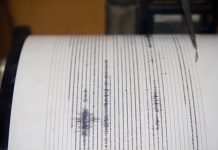The California High-Speed Rail Authority staff has made its selection for the preferred route for the bullet train; cutting straight through Morgan Hill’s downtown, a stop just south of Gilroy’s downtown and a tunnel through Pacheco Pass.
The staff will recommend to the authority board that the train use the existing Union Pacific Railroad corridor from Morgan Hill through Gilroy. This alternative would electrify the tracks currently used by Caltrain.
The plans call for no stop in Morgan Hill, but Northern California Regional Director for the authority, Boris Lipkin, said the newly electrified Caltrain tracks will benefit Morgan Hill. Electrifying the tracks will allow for more lower-speed commuter trains connecting San Jose, Morgan Hill and Gilroy, Lipkin said.
Other options for the High-Speed Rail included viaducts that would run alongside US-101, bypassing both Morgan Hill and Gilroy’s downtown areas, or creating a completely new track between Monterey Road and the Union Pacific Railroad tracks.
Pacheco Pass
The portion of the High-Speed Rail that will pass through Pacheco Pass will include embankments, viaducts and a tunnel.
There will be a 1.5-mile tunnel near Casa De Fruta and a 13.5-mile tunnel through Pacheco Pass.
“There would be a long tunnel around the northern arm of the San Luis Reservoir and viaducts over the California Aqueduct, Delta-Mendota Canal, and I-5,” said the High-Speed Rail information packet.
Tunneling through Pacheco is a major funding obstacle for the authority on a project that has never been fully funded and is currently under threat of losing all federal funding. The announcement of the recommendation July 2 does not guarantee this will be the final route for the High-Speed Rail through San Jose south to Gilroy. The authority will host several town hall meetings over the summer to hear from the community and the board will vote on the alternative at a Sept. 17 board meeting.
The Northern Californian portion of the route has never been fully funded. The authority has recently run into more funding trouble after the Federal Rail Administration sent a notice of funding withdrawal, which would cause the high-speed project to lose nearly a billion dollars.
Morgan Hill
The Morgan Hill portion of the route, as recommended by authority staff, would pass through the existing tracks on Depot Street adjacent to Morgan Hill’s downtown.
Lipkin said that this route would add two tracks to the existing rail lines. He said that in most places the plans fit within the existing space, but other portions of the route would need to be expanded out to accommodate.
There would be platforms on each side of the tracks and gates on either side. In Morgan Hill, the areas surrounding the train tracks are densely populated; Lipkin said the new rail would avoid a new train-themed city park that is right next to the track on Depot Street.
When the train passes through, two barricades would come down to ensure traffic cannot pass.
Despite coming through Morgan Hill’s downtown, Lipkin said, “Alternative 4 has the least impact when it comes to displacement.”
Gilroy
The recommended route for the High-Speed Rail in Gilroy will create a rail hub in the city just outside of downtown.
Other alternative routes for Gilroy would have created a stop near the Gilroy outlets. A stop has always been planned for Gilroy.
“The maximum train speed would be 110 mph where operations would be blended between San Jose and Gilroy,” said the authority information sheet. “South and east of Gilroy, speeds would increase up to 220 mph in the dedicated High-Speed Rail portion of the alignment.”
The Gilroy hub is considered to be a major economic opportunity for the city.
Lipkin said the authority is just working toward getting plans in place and will deal with funding challenges once construction is imminent. “There’s a number of years of work in front of us before we’re ready to issue the big construction contracts,” said Lipkin.
After the authority board approves an alternative, Lipkin said it will take about two years to obtain environmental clearances and advance the designs.
Community meetings will be held this summer to collect feedback on the recommended route:
Aug. 8 in Gilroy; Aug. 21 in Los Banos; Aug. 15 in San Jose; and a Sept. 17 board meeting in San Jose.
According to the authority feedback can also be given by email at sa*************@****ca.gov, by phone at 800-455-8166, or by mail: Northern California Regional Office California High-Speed Rail Authority 100 Paseo De San Antonio, Suite 300 San Jose, CA 95113.











Your taxes will go up . The people pay if something need to be fix. You want that?
Barry, Why won’t you publish my rebuttal and reply to your Article? Joe Thompson (408) 848-5506
And why don’t you ever report the fraud, waste and abuse at the transit agencies VTA (operating ratio 10% LOWEST in USA) COG (farebox recovery rate dipped below legal limit which they reported at 9.9% but would be much worse if they had to use legal accounting like the rest of us are required to use by State and Federal tax regs). To keep their bankrupt boondoggles running, they have to rob gas & diesel taxes paid by motorists, which politicians do to reward their special interest friends at the public sector unions that run the transit vehicles. Why don’t you have your Reporter report on the COG LTA audit results, which you can read if you Google “farebox recovery rates at boondoggle transit agencies.” Joe Thompson (408) 848-5506 Tr******@*****ll.Net PS I mailed you a copy of the Bay Area Transit Agencies insolvency in operations so you ought to give it to your Reporter. I’ll drop over and talk with you about it. jpt PS. Bullet Train is Supersized Boondoggle with same fraud, waste and abuse. jpt To their eternal shame, local politicians help COG cover-up the true extent of their bankrupt boondoggle’s losses. Why don’t you report it? Shine some light on the fraud, waste and abuse at COG. jpt